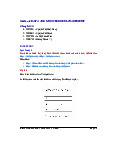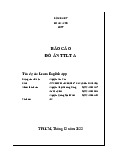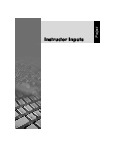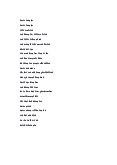








Preview text:
MICROECONOMICS PRACTICE EXERCISES CHAPTER 4 PROBLEM 8
The market for pizza has the following demand and supply schedules:
Price Quantity Demanded Quantity Supplied $4 135 pizzas 26 pizzas 5 104 53 6 81 81 7 68 98 8 53 110 9 39 121
a. Graph the demand and supply curves. What are the equilibrium price and quantity in this market?
b. If the actual price in this market were above the equilibrium price, what would drive the
market toward the equilibrium?
c. If the actual price in this market were below the equilibrium price, what would drive the
market toward the equilibrium? SOLUTIONS
The equilibrium price = $6 and the equilibrium quantity = 81 pizzas.
a. Let the quantity of pizza be measured on the x-axis and the price be measured on the vertical axis. 1/9
From the above graph, it can be seen that the two curves representing quantity supplied
and quantity demanded intersect at point E. E is the point of equilibrium with the
equilibrium price = $6 and the equilibrium quantity = 81 pizzas.
b. If the actual price is above the equilibrium price level ($6), then the quantity supplied
would be greater than the quantity demanded, as 98 > 68. The suppliers in the market would
reduce the price level to $6 to clear their sales. Otherwise, there will be a surplus of pizzas available in the market.
c. If the actual price is below the equilibrium price level ($6), then the quantity supplied
would be less than the quantity demanded, as 53 < 104. The suppliers in the market will
increase the level of their production. Sales will increase to meet the shortage and the price
level would rise to equilibrium. CHAPTER 5 PROBLEM 2
Suppose that business travelers and vacationers have the following demand for airline
tickets from Chicago to Miami: Quantity Demanded Quantity Demanded Price (business travelers) (vacationers) $150 2,100 tickets 1,000 tickets 200 2,000 800 250 1,900 600 300 1,800 400 Required:
1. As the price of tickets rises from $200 to $250, what is the price elasticity of demand
for (i) business travelers and (ii) vacationers? (Use the midpoint method in your calculations.)
2. Why might vacationers have a different elasticity from business travelers? SOLUTIONS 1.
Price elasticity of demand for business travelers
The business traveler’s price elasticity of demand is shown below: 2/9 𝑄 − 𝑄 1900 − 2000 𝑄 −100 450 𝐸 + 𝑄 1900 + 2000 = = = × = −0.23 => |𝐸 𝑃 | = 0.23 − 𝑃 250 − 200 3900 50 𝑃 + 𝑃 250 + 200
The price elasticity of demand will be 0.23.
Price elasticity of demand for vacationers 𝑄 − 𝑄 600 − 800 𝑄 −200 450 𝐸 + 𝑄 600 + 800 = = 𝑃 = ×
= −1.29 => |𝐸| = 1.29 − 𝑃 250 − 200 1400 50 𝑃 + 𝑃 250 + 200
The price elasticity of demand will be 1.29. 2.
Elasticity of vacationers and business travelers
The more substitutes are available for any product, then the elasticity for that product will
be high. Here, the vacationers have a different mode to travel, but for the business travelers,
the only mode is flight as the only option since they have to reach early. Hence, the
demand is elastic for vacationers and inelastic for business travelers. CHAPTER 6 PROBLEM 3
A recent study found that the demand-and-supply schedules for Frisbees are as follows:
Price per Frisbee Quantity Demanded (millions) Quantity Supplied (millions) $11 1 15 10 2 12 9 4 9 8 6 6 7 8 3 6 10 1
a. What are the equilibrium price and quantity of Frisbees?
b. Frisbee manufacturers persuade the government that Frisbee production improves
scientists’ understanding of aerodynamics and thus is important for national security. A
concerned Congress votes to impose a price floor $2 above the equilibrium price. What is
the new market price? How many Frisbees are sold? 3/9
c. Irate college students march on Washington and demand a reduction in the price of
Frisbees. An even more concerned Congress votes to repeal the price floor and impose a
price ceiling $1 below the former price floor. What is the new market price? How many Frisbees are sold? SOLUTIONS (a)
Equilibrium is attained at the point where the quantity demanded is equal to the quantity
supplied. Hence the equilibrium quantity is 6 million Frisbees and the equilibrium price is $8 dollars per frisbee. (b)
A price floor of $2 above the equilibrium price means that the new market price will be
$8+$2=$10. The quantity demanded of Frisbees is 2 million while the quantity supplied is 12 million. (c)
A price floor which should be $1 less than the former price floor will lead to a market price
of $9. The quantity demanded of Frisbees will be 4 million while the quantity supplied will be 9 million. CHAPTER 4 & 6 EXERCISES 1
The market for product M is presented by the following equations: Qs = 4P – 10 Qd = 20 – P Required
1. Determine the equilibrium price and quantity.
2. If the government sets a price ceiling of $8, comment on the market situation for this good.
3. If the government sets a price ceiling of $4, comment on the market situation for this good. 4/9 SOLUTIONS
1. Determine the equilibrium price and quantity. Qs = 4P – 10 Qd = 20 – P Qs = Qd 4P – 10 = 20 – P P = 6, Q = 14
2. Price ceiling at $8, calculate a shortage or a surplus.
- Price ceiling (maximum price) = $8 > Equilibrium price = $6
The price ceiling is set above the market price, so it does not change the market equilibrium. No shortage, no surplus.
3. Price ceiling at $4, calculate a shortage or a surplus. Calculate Qs & Qd
- Qs = 4P – 10 = 4x4 – 10 = 6 units.
- Qd = 20 – P = 20 – 4 = 16 units.
A shortage = Qd – Qs = 16 – 6 = 10 units. CHAPTER 13 PROBLEM 4
Nimbus, Inc., makes brooms and then sells them door-to-door. Here is the relationship
between the number of workers and Nimbus's output in a given day:
a) Fill in the column of marginal products. What pattern do you see? How might you explain it?
b) A worker costs $100 a day, and the firm has fixed costs of $200. Use this information
to fill in the column for total cost. 5/9
c) Fill in the column for average total cost. What pattern do you see?
d) Now fill in the column for marginal cost. What pattern do you see?
e) Compare the column for marginal product and the column for marginal cost. Explain the relationship.
f) Compare the column for average total cost and the column for marginal cost. Explain the relationship. SOLUTIONS 6/9 7/9 e)
When marginal product is rising, marginal cost is falling, and vice versa. f)
When marginal cost is less than average total cost, average total cost is falling; the cost of
the last unit produced pulls the average down. When marginal cost is greater than average
total cost, average total cost is rising; the cost of the last unit produced pushes the average up. CHAPTER 14 EXERCISES 2
ABC Co. has the following data:
Demand equation: P = – Q + 330
Fixed costs: TFC = 1,000 and Variable costs: TVC = 3Q2+ 10Q.
The unit of calculation for P (Price) is thousand VND per product, the unit of calculation
for Q (Quantity) is thousand products per month, the unit of calculation for TR, TC, TFC
and TVC is million VND per month. Required
1. Determine the equation of total revenue (TR) and total cost equation (TC) according to Q.
2. Determine the equation of marginal revenue (MR) and marginal cost (MC) according to the product variable (Q). 8/9
3. With the goal of maximizing revenue, determine the company's sales volume (Q) during
the month. Then, determine the company's maximum revenue.
4. With the goal of maximizing profits, determine the company's monthly sales volume
(Q). Then, determine the company's maximum profit. SOLUTIONS 1) TR = –Q2 + 330*Q TC = 3*Q2 + 10*Q + 1,000
П = TR – TC => П = – 4*Q2 + 320*Q – 1,000 2) MR = – 2*Q + 330 MC = 6*Q + 10
3) TR max: MR = 0 => – 2*Q + 330 = 0 => Q = 165 (thousands of units / month)
Q = 165 => TR max = –Q2 + 330*Q = 27,225 (million VND/ month)
4) П max: MR = MC => – 2*Q + 330 = 6*Q + 10 => Q = 40 (thousands of units / month)
Q = 40 => П max = – 4*Q2 + 320*Q – 1,000 = 5,400 (million VND/ month) The end 9/9




